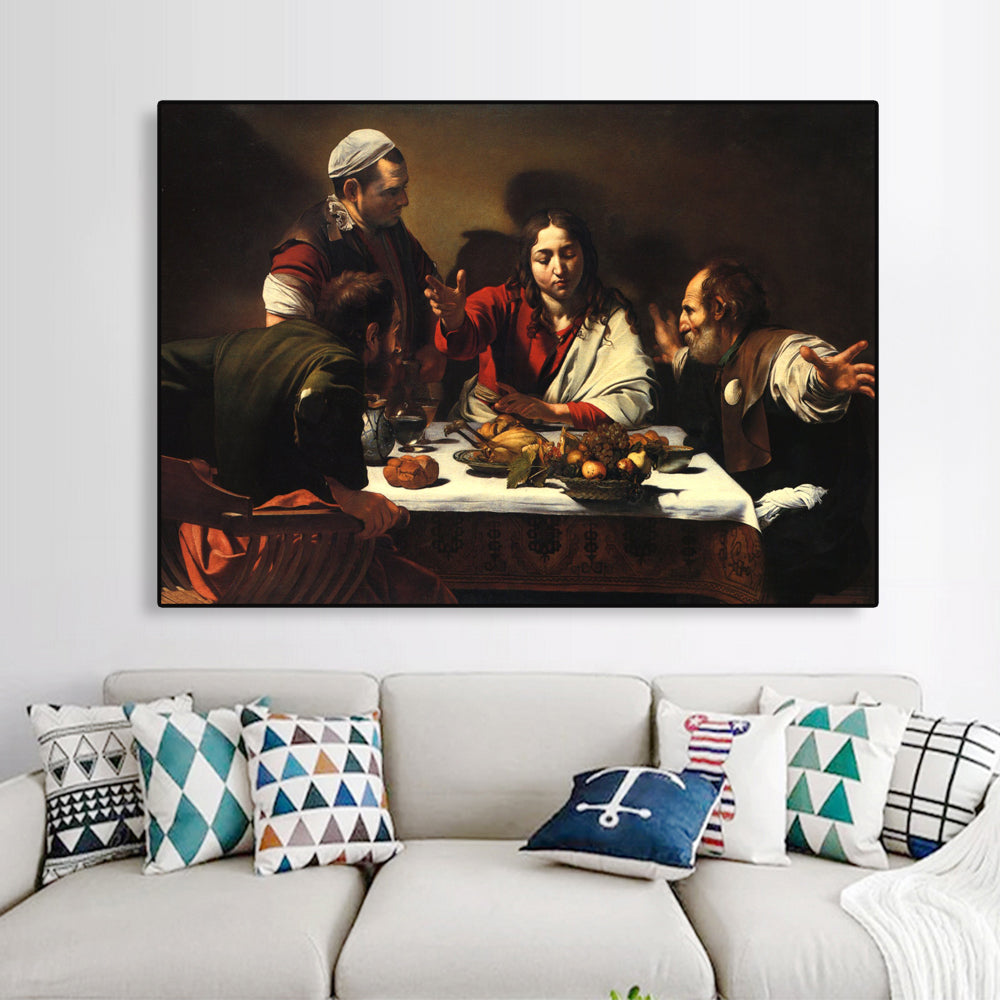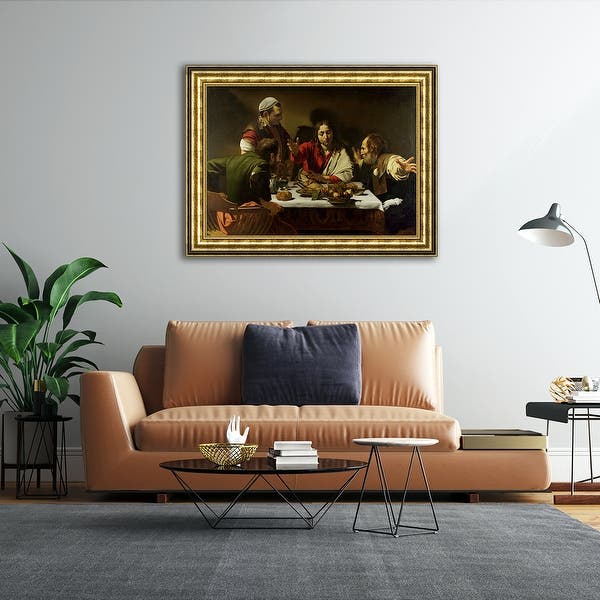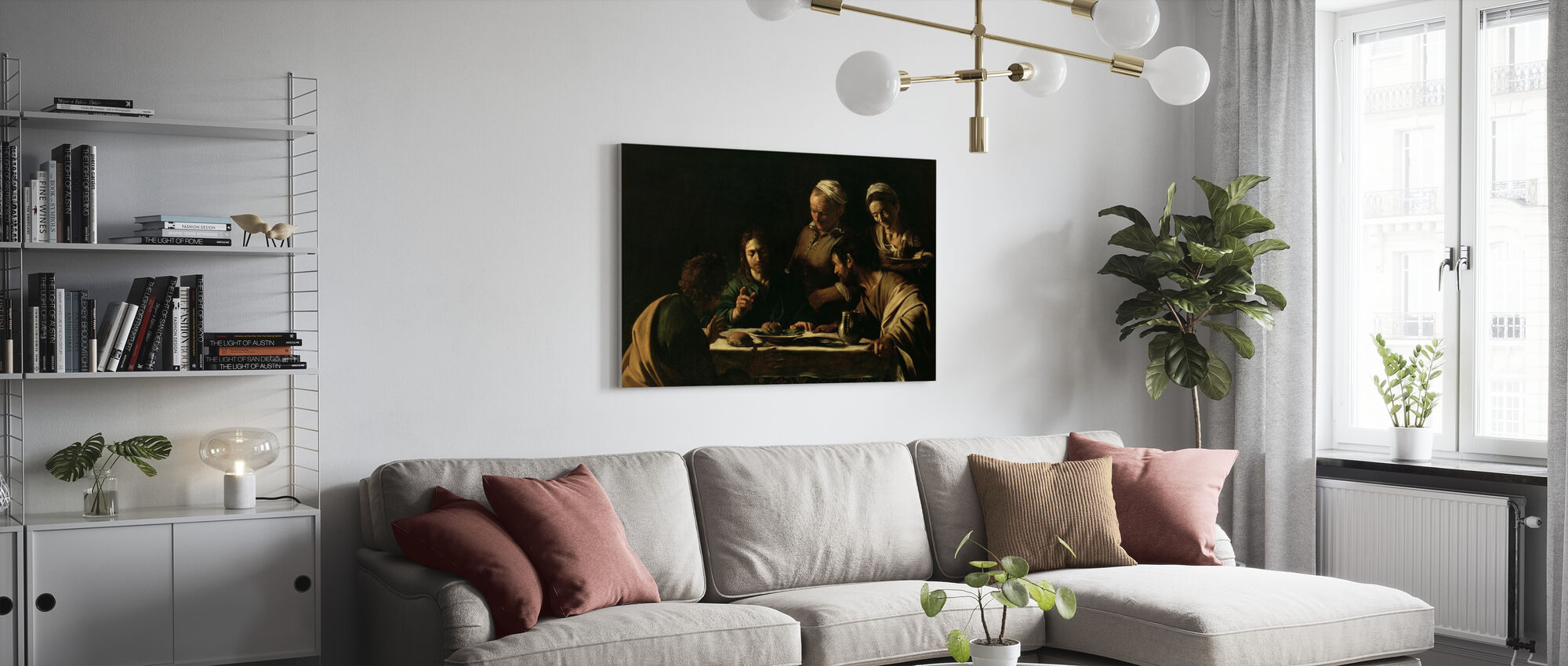Description
This work by the master Caravaggio is also known as The Pilgrimage of Our Lord to Emmaus or simply The Supper at Emmaus. The painting shows the moment when the two apostles who accompany him realize that the one who has been speaking to them all day has been their beloved teacher.
Painted at the height of the artist's fame, this is one of the most impressive religious paintings in the history of art. In this painting, Caravaggio brilliantly captures the dramatic climax of the moment, the exact second when the disciples suddenly realize who has been in front of them from the start. His actions and natural reaction convey his dramatic wonder: one is about to jump out of his chair while the other spreads his arms in disbelief. The harsh lighting underlines the intensity of the entire scene.
In the work, Caravaggio shows the disciples as ordinary workers, with bearded, wrinkled faces and tattered clothes, in contrast to the beardless young Christ, who seems to have come from a different world.
There are some secrets hidden at various points. In the work the artist hid an Easter egg, for example. The shadow cast by the fruit basket on the table also seems to portray a fish, which could be an allusion to the great miracle.
And there are more hidden treasures in this masterpiece. Sometimes a flaw isn't a flaw at all, but a stroke of genius. Take, for example, the weave of the wicker basket teetering on the edge of the table in the center of the painting.
Though countless eyes have marveled at the mysterious drama unfolding within that inn's gloomy interior, the meaning of an almost imperceptible imperfection has hitherto gone unnoticed through the centuries.
A loose twig, protruding from the braid of the fabric, transforms Caravaggio's famous canvas into a daring act, a spiritual challenge for the observer.
To appreciate the full implications of this small detail, it is worth remembering the contours of the general environment that Caravaggio was evoking in his work.
The theme of The Supper at Emmaus is something that has inspired great masters of history, from Rembrandt to Velásquez. The key moment is narrated in the Gospel of Luke in the New Testament. There the story of the intimate meal of Christ with the two disciples, Lucas and Cleofás, who ignore the true identity of the companion is told. In the painting the bread has already been broken and blessed, and the time has come, according to the Gospel account, for Christ to "open" the eyes of his followers and disappear "from their sight."
The masterpiece captures a mystical threshold between shadow and light, the magical second before Christ, who is enveloped by the silhouette of a stranger behind him, disappears from the world. In that immeasurable moment between revelation and disappearance, Caravaggio spins his plot, the masterful encounter between two worlds.
When the truth is revealed, Christ's paternal uncle, Cleopas, rises from his chair in panic and awe at the revelation: his elbows rise dynamically through the sleeves of his coat.
On the other side of the wicker fruit bowl, on the right, Lucas opens his arms wide, as if reclaiming the implausibility of the scene, drawing the same posture on the cross at the moment of his painful death. Meanwhile, the innkeeper is unperturbed, staring blankly as he listens to the words that Christ has spoken to his stunned disciples, unable to grasp the meaning of a momentous moment for humanity.
Caravaggio must have been mindful in choreographing this extraordinary scene, balancing it between the perishable realm and one beyond. It is one thing to illustrate a moment of revelation that other artists have dared to capture in art. It is quite another to make viewers of his work truly participate in the wonder of epiphany: to transform the canvas into the very stage on which a spiritual awakening is both potential and actual.
There, in that moment of collective astonishment, the beloved son of God, the long-awaited messiah, has become a reality and fully complies with all the scriptures.
The choice of fruit on the table is also deliberate of course; because combined with the other elements of the table, they have a symbolic meaning. The apple, rotting here, represents the symbol of temptation and the fall of man. The coming of Christ is symbolized by the ray of light reflected through the glass container on the tablecloth, which can be understood as a symbol of the virgin birth - the light penetrates the glass without breaking it - and the bread is easily recognizable as a symbol of the body of Christ, his incarnation.
Finally, the sacrifice of Christ is symbolized by the grapes that Bellori criticizes. Grapes are the source of wine, which becomes, in the Roman Catholic Eucharist, the Blood of Christ. Consequently, Caravaggio has used the fruit basket to emphasize and underpin the meaning of the story he has painted.
Caravaggio has chosen to represent in this work a dramatic moment in human history, namely that split second in which two nearby apostles realize they are witnessing a miracle of unimaginable power. The great artist masterfully freezes the moment. The artist makes that moment permanent, while allowing the viewer to take their time, consider the miracle embodied on the canvas, and experience that sense of shock and awe felt by the two apostles.
This is without a doubt a true Renaissance masterpiece and a favorite religious painting of the Kuadros team.
Supper at Emmaus is ranked no. 82 on the list of famous paintings




